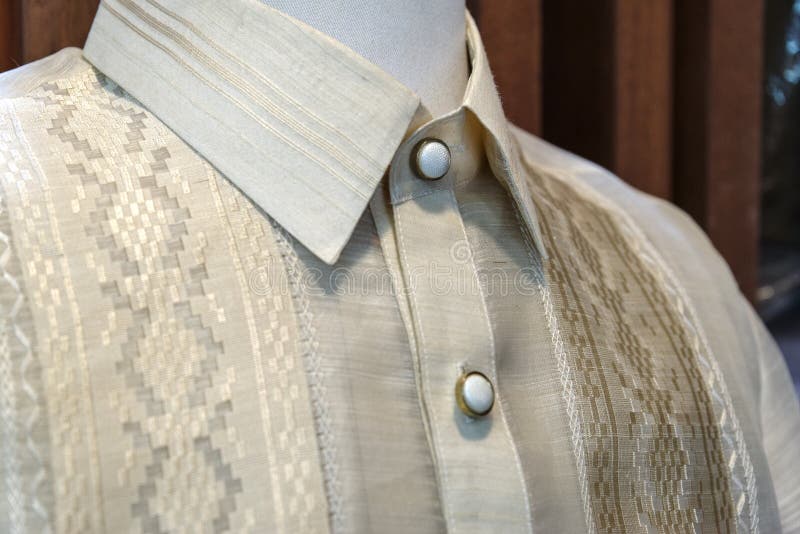9 Simple Techniques For Barong Tagalog For Men
Table of ContentsAbout Modern Barong TagalogThe 10-Minute Rule for Barong TagalogOur Barong Tagalog Dress IdeasThe Ultimate Guide To Filipino Barong TagalogThe 10-Minute Rule for Barong TagalogThe Ultimate Guide To New Style Barong Tagalog
This sort of barong tagalog prevailed among government employees as well as entrepreneurs, who generally used them underneath jackets (chaqueta). Large baro were additionally used by locals and also mestizos for carnivals, recreation tasks like dancing, or for church. Western-style matches came to be much more popular among trainees of the expanding informed course.It was made from nontransparent product (which can be white or darker colors) as well as was matched with white trousers. A generally duplicated however false belief is that the Spanish colonizers made the natives use their barong tagalog with the shirt tails hanging out to differentiate them from the ruling class; its clear fabric allegedly revealing that the user was not hiding a weapon below.
No regulations mandated using large material or banned the tucking in of males's tee shirts. Baro were always put on untucked, even in the precolonial duration; as well as up till the 19th century, they were not made from clear nipis textile. While the design as well as textiles worn by various classes did differ over the Spanish colonial period, this was due to fashion, wide range, as well as course difference, as opposed to law.
The Ultimate Guide To Modern Barong Tagalog
Natives (indios came down from precolonial nobility) as well as (both mestizos de Espaol and) were additionally component of the aristocratic upper classes () and also it wasn't restricted to Europeans - click resources. Indios and also mestizos, despite class, wore barong tagalog and European-style clothing depending on what they can pay for and which were stylish at the time.
American colonial age [edit] The popularity of barong tagalog additionally wound down throughout the American colonial duration. It was replaced by fits (recognized as Americana in the Philippines) and tuxedos in most official functions. In contrast, women continued using the indigenous (a modernized and also merged version of the ), which was then related to suffragists. A noteworthy barong tagalog during this period was the "Commonwealth Barong Tagalog" used by Head of state Manuel L. Quezon, which featured embroidery of the flags of the Commonwealth of the Philippines and also the United States. Other than this, Quezon primarily put on American-style official wear as well as did not promote the barong tagalog.
He intentionally wore a barong tagalog at his commencement - modern barong tagalog. The press played up the significance of Magsaysay in a barong tagalog and the outward bound Quirino in a western-style fit as symbolic of the "break" in between the independent Philippines and also its colonial past.
The Definitive Guide to Barong Tagalog For Women
Magsaysay's use the barong tagalog as formal clothes was extraordinary in modern-day times. His instance was adhered to by other Philippine presidents, and by the time of Diosdado Macapagal's term in the 1960s, it had actually restored its condition as formal wear. Ferdinand Marcos, in certain, put on barong tagalog at virtually every celebration.
June 5 to 11 was also proclaimed as the "Barong Tagalog Week". Following Marcos' mandate, barong tagalog became commonly mandated as office wear for both staff members of the government and also personal firms, along with institution attires. In the 1970s to the 1980s, firms like the Philippine Airlines, Ayala Company, and also the Allied Bank were prescribing barong tagalog as their attires.

The Barong Tagalog Stores PDFs

Grooms now virtually always barong tagalog, while women preferred western-style wedding gowns. Detail of the fabric and needlework on a barong tagalog Regular barong tagalog put on at a wedding celebration The finest barong tagalog are made from a range of indigenous large textiles (nipis). The most usual traditional products made use of are provided below.
It has a great glossy silk-like structure and has an all-natural yellow-colored tinge. It is the most expensive and also extremely prized material for barong tagalog, due to its manufacturing problem, quality, and rarity.
Pia seda a traditional material produced by interweaving pia and silk (seda) fibers. It is normally much less pricey than barong tagalog made simply from pia, yet is extra costly than other kinds of product.
Getting The Where To Buy Barong Tagalog Near Me To Work

From the 1960s onwards, most textiles classified as jusi are in fact jusilyn and also fabric fabrics. These textiles are not typical, but are cheaper mechanically woven substitutes greatly from China. Pia jusi comparable to pia seda, it interweaves pia fibers with jusi fibers. It is more economical than pure pia, however is extra pricey than pure jusi.
It is mainly a product of the Bicol Region. Sinamay a standard nontransparent material made from loosely woven abaca fibers. It is cheaper than other abaca products as well as has a crude structure. Jusilyn a modern-day mechanically woven textile made from silk or cotton and polyester, particularly made to resemble jusi material.
More About Barong Tagalog
Unlike pia, it has check out this site fibers with an also appearance and a beige shade, doing not have the particular streaks of pia or jusi. It can often be chemically repainted to provide an appearance more detailed to traditional textiles, and also may even be sold off as fake pia or pia seda textiles - try here. a contemporary mechanically woven material made from silk or polyester from China.